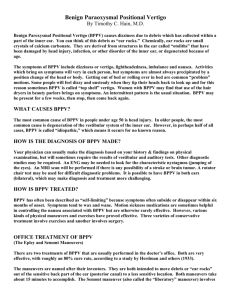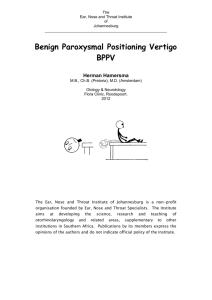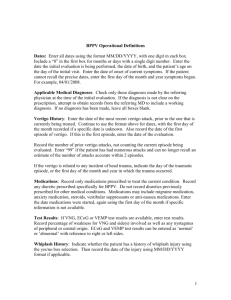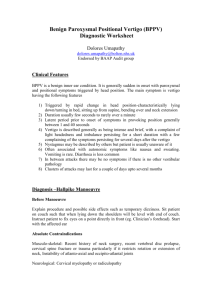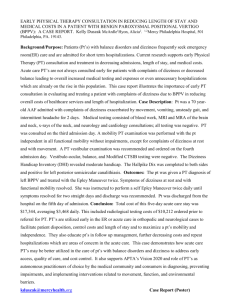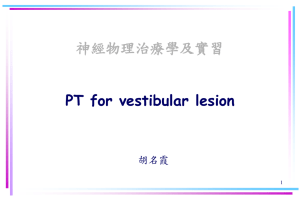Journal Club Summary
advertisement
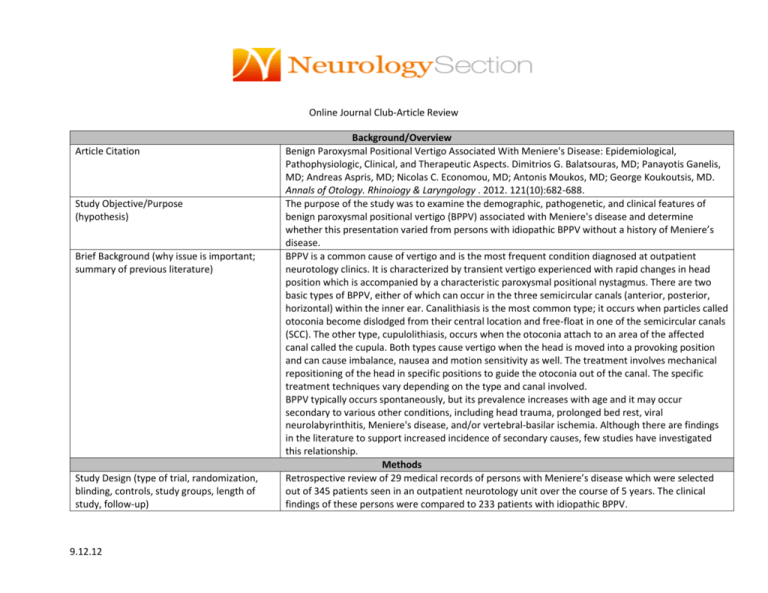
Online Journal Club-Article Review Article Citation Study Objective/Purpose (hypothesis) Brief Background (why issue is important; summary of previous literature) Study Design (type of trial, randomization, blinding, controls, study groups, length of study, follow-up) 9.12.12 Background/Overview Benign Paroxysmal Positional Vertigo Associated With Meniere's Disease: Epidemiological, Pathophysiologic, Clinical, and Therapeutic Aspects. Dimitrios G. Balatsouras, MD; Panayotis Ganelis, MD; Andreas Aspris, MD; Nicolas C. Economou, MD; Antonis Moukos, MD; George Koukoutsis, MD. Annals of Otology. Rhinoiogy & Laryngology . 2012. 121(10):682-688. The purpose of the study was to examine the demographic, pathogenetic, and clinical features of benign paroxysmal positional vertigo (BPPV) associated with Meniere's disease and determine whether this presentation varied from persons with idiopathic BPPV without a history of Meniere’s disease. BPPV is a common cause of vertigo and is the most frequent condition diagnosed at outpatient neurotology clinics. It is characterized by transient vertigo experienced with rapid changes in head position which is accompanied by a characteristic paroxysmal positional nystagmus. There are two basic types of BPPV, either of which can occur in the three semicircular canals (anterior, posterior, horizontal) within the inner ear. Canalithiasis is the most common type; it occurs when particles called otoconia become dislodged from their central location and free-float in one of the semicircular canals (SCC). The other type, cupulolithiasis, occurs when the otoconia attach to an area of the affected canal called the cupula. Both types cause vertigo when the head is moved into a provoking position and can cause imbalance, nausea and motion sensitivity as well. The treatment involves mechanical repositioning of the head in specific positions to guide the otoconia out of the canal. The specific treatment techniques vary depending on the type and canal involved. BPPV typically occurs spontaneously, but its prevalence increases with age and it may occur secondary to various other conditions, including head trauma, prolonged bed rest, viral neurolabyrinthitis, Meniere's disease, and/or vertebral-basilar ischemia. Although there are findings in the literature to support increased incidence of secondary causes, few studies have investigated this relationship. Methods Retrospective review of 29 medical records of persons with Meniere’s disease which were selected out of 345 patients seen in an outpatient neurotology unit over the course of 5 years. The clinical findings of these persons were compared to 233 patients with idiopathic BPPV. Target Population (dx, acuity, inclusion/exclusion critieria) Interventions (if applicable): (specificity of interventions, ability to replicate, frequency, duration) Outcome Measures (relevant to purpose of the study; reliable, valid, clinical utility) Statistical Analysis (statistics used, appropriate application) Enrollment/Subject Characteristics (sample size, gender, age, functional level; were groups similar on important variables prior to application of the intervention) The target population was persons treated in the outpatient neurotology unit with a confirmed diagnosis of Meniere’s disease based on the guidelines of the American Academy of OtolaryngologyHead and Neck Surgery (AAO-HNS). The control group included persons treated at the same clinic during the same five year window that were diagnosed with idiopathic BPPV. Patients hospitalized during the study period with an acute exacerbation of Meniere’s disease were excluded. All patients reviewed received the Dix-Hallpike maneuver and the supine Roll test; both of which are used to assess for the presence of BPPV. Posterior SCC BPPV was the most common and was treated by the modified Epley canalith repositioning procedure. Horizontal SCC BPPV was treated by the barbecue maneuver or the Gufoni maneuver. In some cases, more frequently in the control group, one treatment maneuver may have remediated the BPPV. When symptoms remained, the same repositioning maneuvers were performed every 2 or 3 days, up to a maximum of 7 sessions. The treatment was considered successful once the patient was symptom-free for two months and tested negative for the Dix-Hallpike maneuver and supine Roll test. When symptoms re-occurred the same procedure for assessment and interventions was performed. The only measurement tool mentioned was a nominal scale from 1-3 used to evaluate the severity of the vertiginous symptoms. The scale was described as follows: 1 — slight vertigo in the provoking position without autonomous symptoms; 2 — severe vertigo with nausea; 3 — severe vertigo with severe nausea, vomiting, or hypotension. This scale appears to be unique to this study. The researches described the prevalence of continuous variables as mean ± SD. Categorical variables were expressed as frequencies and percentages. The significance of differences between groups was evaluated by t-test for independent samples. The x2 test was used to evaluate any potential association between categorical variables. The researchers used the Fisher exact probability test for comparisons with small samples. Odds ratios and 95% confidence intervals were calculated to estimate intervention results. Results This retrospective study found 29 persons with Meniere's disease in a group of 345 persons with BPPV (8.4%). The mean age was 55.6 + 9.5 years old in the study group with a range of 37-74 years of age. The mean in the control group was 53.1 + 9.9 years old; range 25-86 years of age. The gender was predominately female in the study group (93.1% vs 6.9% male). The difference in gender was not as prevalent in the control group (59.2% female vs 40.8% male). This study, as well as several others cited, found that almost all patients had BPPV in the same ear as their Meniere's disease. This finding led researchers to describe a causal relationship between these two conditions. Some explanations for this finding include the theory that the presence of endolymphatic hydrops may result in destruction of the maculae of the utricle and saccule, from either compromised vascular supply or 2 Summary of Primary and Secondary Outcomes (include aggregate and sub-group findings if reported); note results that were statistically significant; How many reached a level of clinical significance (exceed MCID if known); Was there retention of changes following intervention (if studied) Brief Summary of Authors’ Main Discussion Points; Authors’ Conclusion Study Strengths Study Limitations and Potential for Bias detachment of otoconia increasing the prevalence of BPPV. This theory is strengthened by the finding that those with advanced Meniere’s, who are more likely to have these structural changes, were more likely than those in the beginning stages to have secondary BPPV. Statistically significant differences in the study group, as compared to the idiopathic BPPV group, were found for several variables. These included: female gender, increased duration of symptoms, and more frequent involvement of the horizontal SCC. Furthermore, canal paresis also occurred at a higher rate in the study group (p <0.005): 17 patients (58.6%); compared to 19 persons (24.3%) in the control group. The final rates of treatment success were similar between the two groups but the persons in the study group required more therapy sessions for successful treatment of BPPV. Only 20.7% had resolution of symptoms with one treatment intervention compared to 78.5% in the control. Furthermore, the recurrence rate was significantly higher in the study group (44.4% vs 13.3 in the control group; p< 0.001. Authors’ Discussion and Conclusions This study is in agreement with previous studies finding that there is an increased incidence of BPPV in persons with Meniere’s disease and that the course of the condition varies from idiopathic BPPV in its epidemiology and disease course. Reviewer’s Discussion and Conclusion The study did a great job of describing secondary BPPV in persons with Meniere’s disease and how these patients often differ from those with idiopathic BPPV. The description of the medical assessment for both the study and control groups was sound. The assessment and treatment of BPPV was also thorough and followed current practice guidelines for this patient population. The findings are conclusive for the specific patient population described and may provide useful considerations when treating persons with Meniere’s disease. The sample was a sample of convenience, reviewing persons with BPPV and Meniere’s disease who were all treated at the same out-patient neurotology unit. The use of an outcome measure such as the Dizziness Handicap Inventory would have been helpful to measure pre and post intervention subjective reports of dizziness and participation limitation. Finally, the study did not specify the type of BPPV for anterior or posterior canal; only for horizontal canal BPPV. Because the types are often treated with different interventions this information would have been useful. Applicability: Types of patients (dx) that results apply to Persons with Meniere’s disease being seen on an out-patient basis; excluding those with an acute Types of settings or patient acuity that the flare. The results of this study cannot be extrapolated to those with an acute flare of Meniere’s disease. results apply to 3 Can interventions be reproduced? Can results be applied to other pt populations? How will study results impact PT management of this patient population?; List suggestions for how to implement changes in your clinic/department to integrate study findings into patient care Interventions can easily be reproduced as the assessments and interventions described used are commonly used. The results may apply to persons with Meniere’s in other settings, as long as they are not experiencing an acute attack, but cannot be generalized to persons found to have BPPV as a secondary diagnosis to a condition other than Meniere’s disease. Because the incidence of BPPV in the study population was higher than the control group, clinicians should more frequent screening for BPPV in persons with Meniere’s disease. Because the incidence of horizontal canal BPPV was higher in the study group than in the control the Roll test should always be used to screen for BPPV, not just the Dix-Hallpike. Also, the persons in the study with Meniere’s disease who also had BPPV required increased treatment time for resolution of symptoms and tended to have more frequent reoccurrence. This knowledge should influence the treating therapist educate the patient better about what to expect for the treatment course and influence the plan of care. 4

